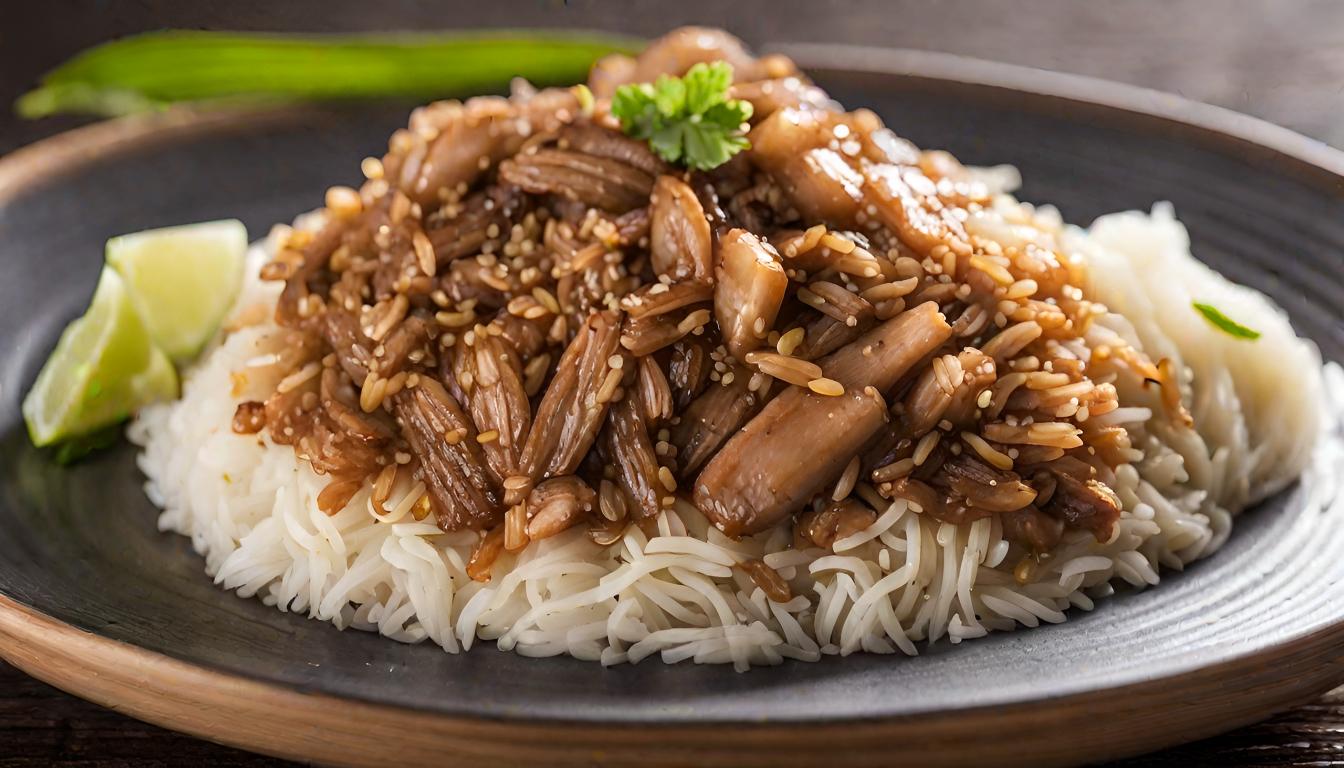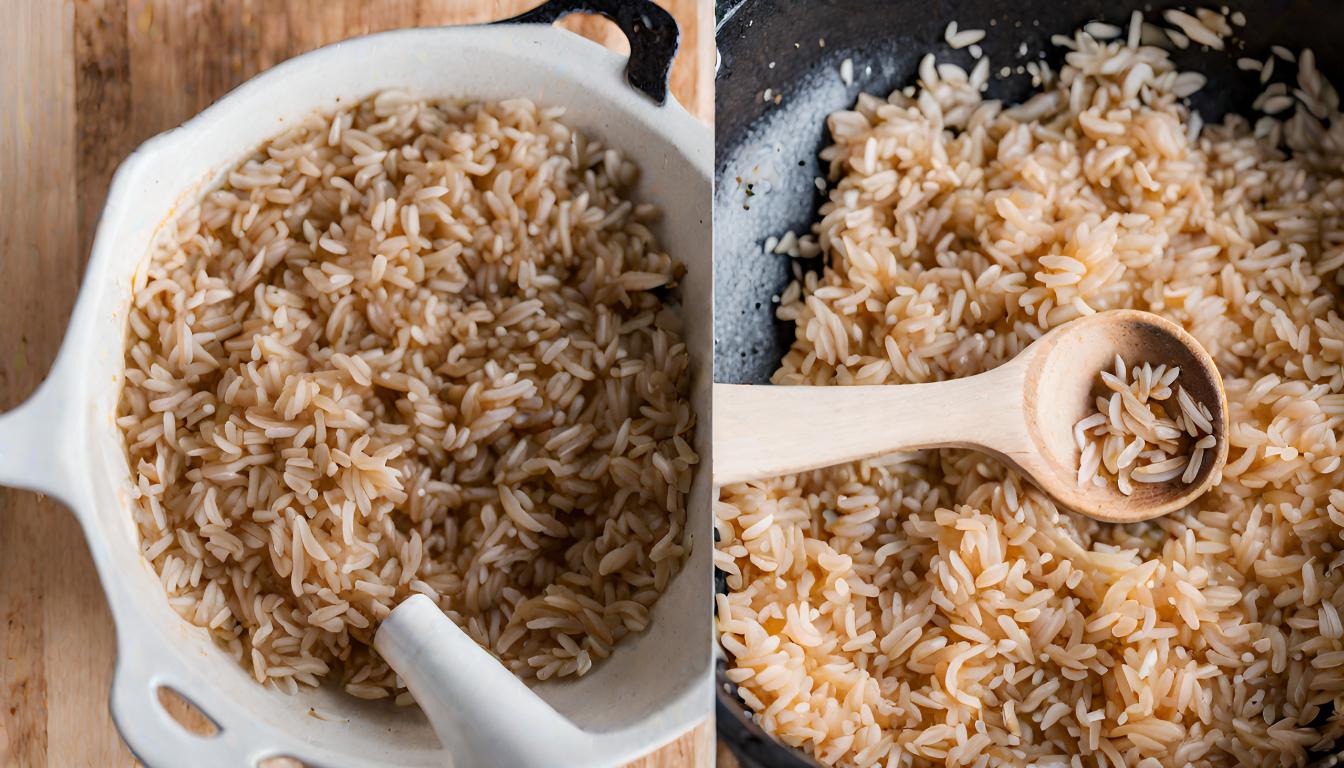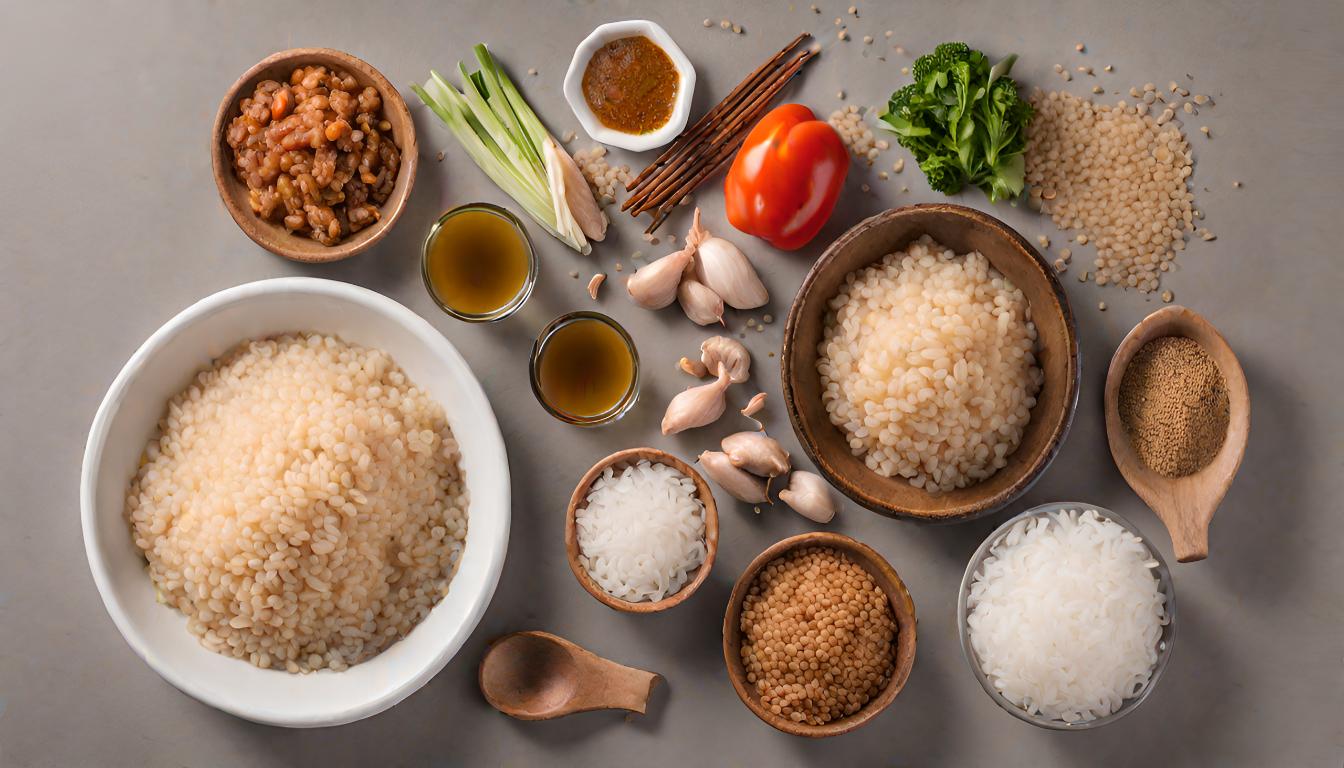Embark on a culinary journey into the heart of Filipino cuisine with the savory delight of Adobo Rice. This article explores the rich flavors, history, and variations of this beloved dish, offering insights and inspiration for both cooking enthusiasts and those new to Filipino flavors.
Introduction to Adobo Rice
Discovering the Delights of Adobo Rice
Adobo , a staple in Filipino cuisine, is a dish that perfectly encapsulates the harmony of flavors that Filipino cooking is renowned for. It’s not just a meal; it’s a celebration of cultural heritage and culinary artistry.
A Culinary Staple in Filipino Cuisine
Adobo Rice is deeply rooted in the culinary traditions of the Philippines. It combines the rich, tangy, and savory flavors of adobo, a popular Filipino cooking process, with the comforting and familiar texture of rice. This dish is a testament to the Filipino love for hearty and flavorful meals.
The Unique Flavor Profile of Adobo Rice
The charm of Adobo lies in its unique blend of soy sauce, vinegar, garlic, and other spices, which are absorbed by the rice, creating a dish that’s bursting with flavor. Each bite offers a taste of the Philippines – a blend of history, culture, and a passion for good food.
In the next part, we’ll delve into the historical background of adobo in Filipino cooking, tracing its origins and cultural significance.
Stay tuned as we explore the rich history of Adobo Rice, uncovering how this dish became a beloved part of Filipino cuisine. Whether you’re a seasoned foodie or just starting to explore Filipino dishes, this journey through the history of Rice is sure to be both enlightening and delicious. For authentic Filipino adobo recipes, Filipino Food Recipes is a great resource to start with.
Historical Background
The Rich History of Adobo in Filipino Cooking
Adobo, the cooking process that forms the foundation of Rice, has a storied history in Filipino cuisine, reflecting the country’s cultural tapestry.
Origins and Cultural Significance
The term “adobo” originally comes from the Spanish word “adobar,” meaning marinade or seasoning. However, the Filipino adobo predates Spanish influence and was already a part of indigenous cooking practices. It evolved to include ingredients introduced during the Spanish colonization, such as vinegar and soy sauce, which are now key components of the dish. Adobo embodies this blend of local and foreign influences, showcasing the adaptability and richness of Filipino culinary history.
Evolution of Adobo Rice Over Time
Over time, Adobo Rice has evolved from a simple way to preserve meat in a vinegar-based marinade to a beloved staple at Filipino tables. Each region in the Philippines offers its own twist on adobo, with variations in ingredients and cooking methods. This evolution reflects the diversity of Filipino cuisine and the creativity of its people in the kitchen.
In the next part, we’ll explore the traditional recipe for Adobo Rice, including the essential ingredients and the step-by-step process to create this flavorful dish.
Stay tuned as we share the secrets of preparing classic Adobo Rice. Whether you’re an experienced cook or new to Filipino cuisine, our upcoming section will guide you through creating this delicious and comforting dish at home. For exploring more rice dishes from around the world, Serious Eats – Rice Dishes offers a wide range of recipes and insights.

Traditional Adobo Rice Recipe
Preparing Classic Adobo Rice
Adobo Rice, with its rich and savory flavors, is a dish that brings comfort and joy to any meal. Let’s explore how to prepare this classic Filipino dish.
Essential Ingredients and Their Roles
To make authentic Adobo Rice, you’ll need:
- Rice: The base of the dish, usually long-grain white rice, which absorbs the flavors well.
- Meat: Typically chicken or pork, marinated and cooked in adobo sauce.
- Soy Sauce and Vinegar: The core of adobo’s flavor, providing a balance of salty and tangy tastes.
- Garlic: Essential for its aromatic and flavor-enhancing properties.
- Bay Leaves and Black Peppercorns: For added depth and a hint of spice.
Step-by-Step Cooking Process
- Marinate the Meat: Combine soy sauce, vinegar, garlic, bay leaves, and peppercorns. Marinate the chicken or pork for at least an hour.
- Cook the Meat: In a pot, cook the marinated meat until tender and the sauce reduces.
- Prepare the Rice: Cook the rice as you normally would, either in a rice cooker or on the stovetop.
- Combine: Once the meat is cooked, add the cooked rice to the pot, stirring gently to mix with the adobo sauce and meat.
- Serve: Serve the Adobo Rice hot, garnished with fresh herbs or fried garlic for an extra flavor boost.
In the next part, we’ll explore modern variations of Adobo Rice. From fusion recipes to vegetarian adaptations, we’ll see how this traditional dish can be transformed to suit various tastes and dietary preferences.

Modern Variations
Contemporary Twists on Traditional Adobo Rice
Adobo Rice, while deeply rooted in tradition, lends itself beautifully to modern interpretations and creative culinary twists.
Fusion and Innovative Recipes
- Adobo Rice with International Flavors: Chefs and home cooks have begun infusing Adobo Rice with elements from other cuisines, such as adding a hint of coconut milk for a Thai twist or incorporating spices like cumin for a Mexican flair.
- Adobo Rice Bowls: A trendy take on the classic, these bowls feature Adobo Rice topped with a variety of ingredients like fresh vegetables, avocado, and a fried egg, catering to the growing popularity of bowl meals.
Vegetarian and Vegan Adaptations
- Vegetarian Adobo Rice: For a meat-free version, mushrooms or tofu can be used as substitutes for chicken or pork. These ingredients beautifully absorb the adobo flavors, making the dish suitable for vegetarians and vegans.
- Vegan Adobo Sauce: To make the adobo sauce vegan-friendly, a combination of soy sauce, vinegar, garlic, and plant-based sweeteners can be used. This adaptation ensures that the essence of adobo is maintained while adhering to vegan dietary requirements.
In the next part, we’ll delve into the nutritional information of Adobo Rice. We’ll explore its health benefits, dietary considerations, and ways to balance flavor with health.
Stay tuned as we examine the nutritional aspects of Adobo Rice, offering insights into how this flavorful dish can fit into a healthy and balanced diet. Whether you’re a health-conscious foodie or simply looking to enjoy Adobo Rice in a healthier way, our upcoming section will provide valuable information and tips. For more on the nutritional benefits of traditional dishes, Healthline – Nutritional Benefits offers a wealth of knowledge.

Nutritional Information
Understanding the Nutritional Profile of Adobo Rice
While Adobo Rice is a delightful treat, being aware of its nutritional profile helps in enjoying this dish in a balanced way.
Health Benefits and Dietary Considerations
Adobo Rice, with its combination of rice and marinated meat, can be a hearty meal. The key ingredients, like soy sauce and vinegar, contribute to its unique flavor but also add sodium. The use of meat, typically chicken or pork, provides protein, making it a filling dish. However, for those watching their calorie intake, portion control is essential.
Balancing Flavor and Health
For a healthier version of Adobo Rice:
- Use Leaner Cuts of Meat: Opt for chicken breast or lean pork cuts to reduce fat content.
- Increase Vegetables: Add more vegetables to the dish, such as bell peppers, carrots, or peas, to increase its nutritional value.
- Control Portion Sizes: Be mindful of serving sizes to manage calorie intake effectively.
In the next part, we’ll explore serving and pairing suggestions for Adobo Rice. From ideal accompaniments to presentation tips, we’ll provide ideas to enhance your Adobo Rice experience.

Serving and Pairing Suggestions
Enhancing Your Adobo Rice Experience
Serving Adobo Rice isn’t just about dishing it out; it’s about creating a complete dining experience that complements its rich flavors.
Ideal Accompaniments and Pairings
- With Vegetables: Pair Adobo Rice with a side of steamed or stir-fried vegetables for a balanced meal. This not only adds color and nutrition but also complements the savory flavors of the dish.
- Protein Options: For a more substantial meal, serve Adobo Rice with additional protein like grilled fish or tofu, especially if you’re opting for a vegetarian version of the dish.
- Beverage Pairings: A light beer or a crisp white wine can pair beautifully with Adobo Rice, balancing its rich flavors with their refreshing notes.
Presentation and Serving Tips
- Plating Techniques: Serve Adobo Rice in a shallow bowl or a plate, garnishing with fresh herbs like cilantro or green onions for a pop of color and freshness.
- Family Style: For family gatherings, consider serving Adobo Rice in a large platter, family-style, allowing everyone to help themselves.
- Creative Presentation: For a more creative presentation, use molds to shape the rice into attractive forms on the plate, adding an element of elegance to your meal.
In the next part, we’ll address some of the most common questions about Adobo Rice. From preparation tips to storage advice, we’ll provide answers to the queries that enthusiasts of this dish frequently ask.
Answering Common Questions About Adobo Rice
Let’s dive into some of the most common queries about this beloved Filipino dish.
- How Can You Store Leftover Adobo Rice?
- Leftover Adobo Rice can be stored in an airtight container in the refrigerator for up to 3 days. For longer storage, you can freeze it for up to a month. Just make sure to reheat it thoroughly before serving.
- Can Adobo Rice Be Made with Brown Rice?
- Absolutely! Brown rice can be a healthier alternative to white rice. It adds a nutty flavor and a chewier texture to the dish. Just adjust the cooking time as brown rice takes longer to cook than white rice.
- What Are the Best Meats to Use for Adobo Rice?
- Traditionally, chicken and pork are the most popular choices. However, you can also use beef or even seafood. The key is to marinate the meat well to infuse the adobo flavors.
- Is Adobo Rice Spicy?
- Classic Adobo Rice is not typically spicy. It has a savory flavor profile with a balance of tanginess from the vinegar and saltiness from the soy sauce. However, you can add chili peppers or hot sauce if you prefer a spicy kick.
- Are There Any Quick Ways to Prepare Adobo Rice?
- For a quicker version, you can use pre-cooked or leftover rice and combine it with cooked adobo meat. This can significantly reduce the preparation time, making it a convenient option for busy days.
In the final part of our article, we’ll wrap up with some concluding thoughts on the enduring charm of Adobo Rice. We’ll recap the key points and leave you with some final reflections on this Filipino culinary staple.
Conclusion
Embracing the Rich Flavors of Adobo Rice
Adobo Rice is more than just a dish; it’s a celebration of Filipino culinary heritage, a testament to the rich tapestry of flavors that define Filipino cuisine.
Recap and Final Thoughts
- A Culinary Staple: Adobo Rice, with its savory and tangy flavors, has firmly established itself as a beloved staple in Filipino cooking, enjoyed in homes and restaurants alike.
- Versatile and Adaptable: This dish not only honors tradition but also embraces innovation, allowing for various adaptations and modern twists that cater to diverse tastes and dietary preferences.
- A Dish for All Occasions: Whether it’s a family dinner, a festive gathering, or a simple weekday meal, Adobo Rice brings comfort and joy to any table.
In closing, Adobo Rice is not just a meal; it’s an experience, a journey through the flavors and history of Filipino cooking. Whether you stick to the traditional recipe or experiment with new variations, this dish is sure to bring warmth and satisfaction to your culinary adventures.
As we reach the conclusion of our exploration into the world of Adobo Rice, let’s take a moment to reflect on the unique charm and appeal of this quintessential Filipino dish.
Conclusion
Embracing the Rich Flavors of Adobo Rice
Adobo Rice is more than just a dish; it’s a celebration of Filipino culinary heritage, a testament to the rich tapestry of flavors that define Filipino cuisine.
Recap and Final Thoughts
- A Culinary Staple: Adobo Rice, with its savory and tangy flavors, has firmly established itself as a beloved staple in Filipino cooking, enjoyed in homes and restaurants alike.
- Versatile and Adaptable: This dish not only honors tradition but also embraces innovation, allowing for various adaptations and modern twists that cater to diverse tastes and dietary preferences.
- A Dish for All Occasions: Whether it’s a family dinner, a festive gathering, or a simple weekday meal, Rice brings comfort and joy to any table.
In closing, Adob Rice is not just a meal; it’s an experience, a journey through the flavors and history of Filipino cooking. Whether you stick to the traditional recipe or experiment with new variations, this dish is sure to bring warmth and satisfaction to your culinary adventures.
We hope this journey through the world of Adob nRice has inspired you to try this delicious dish in your own kitchen. Remember, cooking is not just about following a recipe; it’s about bringing a piece of cultural tradition to your table and creating memories that last a lifetime. So go ahead, give Rice a try, and savor the rich flavors of Filipino cuisine. For more insights into Filipino cooking and recipes, Filipino Food Recipes is a wonderful resource to explore.
In exploring the rich and savory world of Rice, it’s fascinating to see how diverse culinary traditions can come together in a single dish. If you’re intrigued by the fusion of flavors, you might also enjoy our Lemon Blueberry Cheesecake,

